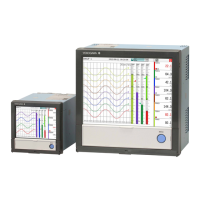App-2
IM 04L51B01-01EN
• DataSizeperSample
Display Data
(Number of I/O channels × 12 bytes) + (number of math channels × 12 bytes) + (number
of communication channels × 12 bytes) + 16 bytes (time data)
EventData
(Number of I/O channels × 6 bytes) + (number of math channels × 6 bytes) + (number of
communication channels × 6 bytes) + 16 bytes (time data)
• SampledDataSizeperFile
Display Data
Data size per sample × saving interval/sampling interval
The sampling interval is determined by dividing the trend interval (in seconds) by 30 (50
if the trend interval is 5 or 10 s).
Example2: When recording the display data for 30 I/O channels, 10 math channels, and
50 communication channels at a trend interval of 30 min/div (the sampling interval of
display data is 60 s), and a saving interval of 1 day (24 h)
(30 × 12 bytes + 10 × 12 bytes + 50 × 12 bytes + 16 bytes) × 24 h × 60 × 60/60 sec
= 1,096 bytes × 24 h × 60 × 60/60 sec
= 1,578,240 bytes
EventData
Data size per sample×data length/Recording interval
Example3: When recording event data for 30 I/O channels, 10 math channels, 50
communication channels at a Recording interval of 1 s and a data length of 2 h
(30 × 6 bytes + 10 × 6 bytes + 50 × 6 bytes + 16 bytes) × 2 h × 60 × 60/1 s
= 556 bytes × 2 h × 60 × 60/1 s
= 4,003,200 bytes
Size per File
The size per file is the sum of the size of information other than the sampled data and the
size of the sampled data and the size of system information.
Display Data
Example4: When recording under the conditions of examples 1 and 2
From examples 1 and 2, we obtain 37,680 + 1,578,240 = 1,615,920 bytes = 1.541 MB
Then, add the size of system information (about 5 KB in this example).
EventData
Example5: When recording under the conditions of examples 1 and 3
From examples 1 and 3, we obtain 37,680 + 4,003,200 = 4,040,880 bytes = 3.946 MB
Then, add the size of system information (about 5 KB in this example).
Appendix 1FileSizeofDisplayDataandEventData

